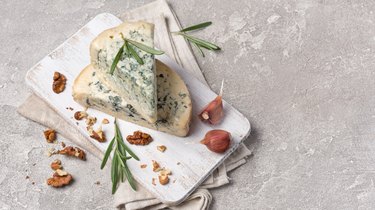
It can be so tempting to just cut mold off cheese and continue as planned, but it's not always safe. It's frustrating to notice spots of fuzzy mold on some cheese you didn't buy very long ago — tossing it feels like a waste of money and delicious food.
Tip
If you see mold on a soft cheese, it’s best to throw it away — side effects of eating bad cheese can be serious. For extremely hard types, like Parmesan, you might be able to cut the mold off the cheese (with a 1-inch margin) and safely eat it.
Video of the Day
On very hard cheeses, it may be safe to remove the mold and eat uncontaminated parts. This is not the case with soft, shredded or crumbled cheeses. Baking moldy cheese at high temperatures to kill the mold is not recommended. Feel free to bake intentionally moldy cheeses, like gorgonzola or brie, for tasty and warming recipes — but if your cheese is not meant to be moldy, baking it won't help salvage it.
Video of the Day
Saving Moldy Cheeses
Can you cut mold off cheese and proceed to eat the rest? According to the Mayo Clinic, it depends. If you notice mold on any soft or spreadable cheeses like ricotta or cottage cheese, you should not eat it.
Mold on cream cheese? Toss it out right away. The same goes for any cheese that is shredded or crumbled. That's because the mold can contaminate more than you can see, spreading through these cheeses.
USDA Food Safety Information explains that you can see three separate parts of mold when you look through a microscope: the root threads that "invade" the food, a stalk rising above the food and spores that form on the ends of those stalks. The spores are what give mold its color. So the visible blue dots of mold on cream cheese are just a fraction of what's really going on.
However, the Mayo Clinic says, it's probably OK to just cut mold off cheeses that are hard or semi-soft like Parmesan, cheddar and Colby cheese. When you do so, cut out any visible mold and at least 1 inch of the cheese around that mold, and take care to keep the knife away from non-contaminated parts of the cheese.
There are a number of cheeses intentionally created using mold, and these guidelines don't apply to them. For example, brie is made using a white mold called Penicillum candidum. There are also blue-veined cheeses, like Gorgonzola and Roquefort, that have mold added to them while they are made. These types of mold are typically not harmful, and add distinctive flavor to the cheeses.
Side Effects of Eating Bad Cheese
Unfortunately, growing alongside any mold in cheese could be potentially harmful bacteria like E. coli, listeria and salmonella — the types of things that cause food recalls. These make the side effects of eating bad cheese quite serious.
The CDC says that soft cheeses and raw milk cheeses carry an increased risk of food poisoning. Common symptoms of food poisoning include vomiting, nausea, diarrhea, abdominal pain, cramps and fever. Some severe cases of food poisoning can contribute to dehydration. Furthermore, a type of food poisoning caused by listeria can potentially be very harmful to pregnant people — it can contribute to miscarriages, premature birth or even stillbirth.
The bottom line is that the right steps to take all depend on the type of cheese you are dealing with. If you see mold on cream cheese, do not attempt to eat it. Mold on blue cheese is meant to be there. Mold on Parmesan cheese can potentially be removed.